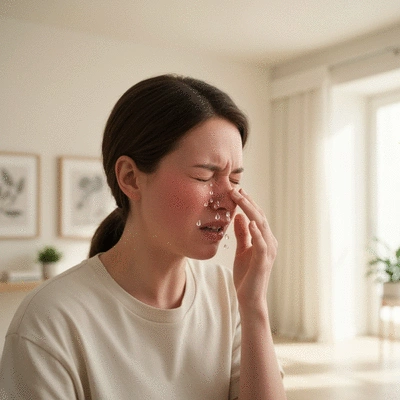Mold Allergy: Understand and Prevent

Did you know that approximately 10% to 20% of people suffer from mold allergies? Understanding this condition is vital for managing your health effectively.
What You Will Learn
- Mold allergies are triggered by immune responses to mold spores found in various environments.
- Identifying common allergens like Aspergillus and Penicillium helps in managing exposure.
- Early diagnosis and proactive management can significantly improve quality of life for those affected.
- Long-term untreated mold allergies can lead to chronic respiratory issues and other serious health conditions.
- Implementing simple preventive measures, like controlling indoor humidity, can reduce mold exposure.
- Seeking professional help is crucial for those experiencing persistent allergy symptoms despite taking preventive action.
- Staying informed on public health guidelines and available resources enhances your ability to manage mold allergies.
Mold Allergy Prevalence and Impact
Studies indicate that approximately 10% to 20% of the population experiences some form of mold allergy. This visual highlights the prevalence and key implications of untreated mold allergies.
Prevalence of Mold Allergy
of the population affected
This statistic underscores the widespread nature of mold allergies, highlighting the need for awareness and management.
Long-Term Health Implications (Untreated)
- Chronic respiratory issues
- Worsening asthma
- Increased risk of sinus infections
- Potential for mold-related diseases
Key Prevention Strategies
- Keep humidity below 50%
- Clean AC units regularly
- Ensure good ventilation
- Use mold-resistant products
Importance of Early Action
- Better management strategies
- Early intervention & treatment
- Differentiate symptoms
- Improved quality of life
Mold Allergy: Understanding the Basics and Its Impact on Health
Mold allergies are becoming increasingly common, affecting countless individuals across various environments. At I’m Allergic, I understand the challenges faced by those dealing with allergies, including mold. It's essential to grasp the basics of mold allergies to better navigate life with this condition.
Mold allergy is an immune response triggered by exposure to mold spores, which are tiny particles released into the air. These spores can easily find their way into our homes, workplaces, and even outdoor environments. Understanding the prevalence of mold allergies is crucial for anyone looking to manage their health effectively.
Defining Mold Allergy and Its Prevalence
A mold allergy occurs when your immune system overreacts to inhaled mold spores. This can lead to a range of uncomfortable symptoms, from sneezing to more severe respiratory issues. In fact, studies indicate that approximately 10% to 20% of the population experiences some form of mold allergy! This statistic highlights the need for awareness and education. For more detailed information on mold allergies, you can consult authoritative sources like the Mayo Clinic's guide to mold allergy.
- Common allergens include species like Aspergillus, Penicillium, and Cladosporium.
- People with existing respiratory conditions, such as asthma, are particularly at risk.
- Awareness of mold allergy prevalence can empower individuals to seek testing and treatment.

By knowing how prevalent mold allergies are, we can take steps to educate ourselves and others about managing this condition more effectively.
Why Understanding Mold Allergies is Essential for Your Health
Understanding mold allergies is vital for several reasons. First, it helps inform lifestyle choices and environmental controls that can minimize exposure. If you know you're allergic, you can make proactive decisions about your living and working environments. This knowledge can lead to improved quality of life, which is something I’m passionate about at I’m Allergic.
- Identifying triggers allows for better management strategies.
- Awareness can lead to early intervention and treatment.
- Understanding symptoms can help differentiate between mold allergies and other conditions.
Ultimately, the more you know about mold allergies, the better equipped you are to advocate for yourself and seek the necessary support. This proactive approach is essential for maintaining health and well-being!
Identifying the Causes and Risk Factors of Mold Allergy
To effectively manage mold allergies, it's essential to identify the causes and risk factors at play. Mold spores are everywhere, and knowing what contributes to their presence can help us reduce exposure and prevent allergic reactions.
In the following sections, we will explore the specific roles of mold spores, environmental conditions that foster growth, and lifestyle factors that may increase your risk. Let’s dive in!
Did You Know?
According to recent studies, mold spores can remain dormant for years before becoming active. This means that even if you think your environment is mold-free, hidden spores can still pose a risk to those with allergies.
Staying vigilant and consistently monitoring your surroundings is crucial for effective mold allergy management!
Frequently Asked Questions About Mold Allergies
What is a mold allergy?
A mold allergy is an immune system reaction to inhaled mold spores, leading to symptoms such as sneezing, runny nose, itchy eyes, and sometimes more severe respiratory issues like asthma attacks.
How common are mold allergies?
Approximately 10% to 20% of the population experiences some form of mold allergy, making it a widespread condition.
What are the long-term health implications of untreated mold allergies?
Untreated mold allergies can lead to chronic respiratory issues, worsening asthma, increased risk of sinus infections, and potentially more serious mold-related diseases.
What are some key prevention strategies for mold?
Effective prevention strategies include keeping indoor humidity below 50%, regularly cleaning and maintaining air conditioning units, ensuring good ventilation in moisture-prone areas, and using mold-resistant products in home renovations.
When should I seek professional help for mold allergy symptoms?
If you experience persistent symptoms despite implementing preventive measures, or if your symptoms worsen, it's essential to seek professional help from an allergist for tailored strategies and treatments.
Summarizing Key Insights on Mold Allergy Management
As we wrap up our discussion on mold allergies, it's crucial to consider the long-term health implications if these allergies remain untreated. Mold allergies can lead to chronic respiratory issues, worsening asthma, and even more severe health conditions if exposure continues. This is why managing your mold allergy is not just about immediate relief; it’s about safeguarding your future health! For comprehensive information on mold and health, refer to resources from the CDC on mold and health.
Additionally, untreated mold allergies can trigger the development of more serious conditions like allergic fungal sinusitis. Thus, understanding the full scope of your allergies is essential to prevent them from negatively impacting your everyday life.
Long-Term Health Implications of Untreated Mold Allergy
- Chronic respiratory issues, like asthma exacerbation
- Increased risk of sinus infections and headaches
- Potential development of mold-related diseases
- Impact on mental health due to ongoing symptoms
These implications illustrate the importance of staying proactive in your allergy management. If you notice symptoms worsening or persistent issues, don't hesitate to seek out resources and support to help you navigate these challenges effectively.
The Importance of Early Diagnosis and Proactive Management
Another key takeaway is the significance of early diagnosis. By identifying your mold allergy sooner rather than later, you can take proactive steps to manage your environment and symptoms effectively. Working with healthcare professionals ensures you are on the right track, utilizing the best strategies for your individual needs.

At I’m Allergic, we believe that proactive management includes understanding your triggers, engaging with your community, and utilizing the resources available to you. Whether you need allergy testing or specific advice on managing exposures, early intervention can lead to a significantly improved quality of life.
Taking Action: Your Next Steps for Mold Allergy Prevention
Now that we've covered key insights, it’s time to focus on implementing prevention strategies in your daily life. Small changes can make a big difference in minimizing your risk of mold exposure and improving your overall well-being. For more information on environmental health topics, including mold, the National Institute of Environmental Health Sciences (NIEHS) offers valuable resources.
Consistency is key! Make these adjustments a regular part of your routine, and you'll find it much easier to manage your mold allergy over time.
Implementing Prevention Strategies in Daily Life
- Keep indoor humidity levels below 50% using dehumidifiers
- Regularly clean and maintain air conditioning units
- Ensure good ventilation in bathrooms and kitchens
- Use mold-resistant products in home renovations
Taking these small yet impactful steps can help create a safe environment for you and your loved ones. Remember, proactive measures today can lead to healthier tomorrows!
Seeking Professional Help and Advice for Persistent Symptoms
If you experience ongoing symptoms despite your best efforts, it’s essential to seek professional help. Allergists can provide tailored strategies and treatments that fit your specific needs. Don't hesitate to reach out for support—you're not alone in this!
Sometimes, sharing your experiences with healthcare professionals can lead to discovering new treatment options that you may not have considered. Together, we can navigate this journey to better health.
Understanding Public Health Guidelines and Educational Resources on Mold Exposure
Finally, staying informed is one of the best ways to manage your mold allergies. Familiarize yourself with public health guidelines regarding mold exposure in your area. Resources such as the Environmental Protection Agency (EPA) offer valuable information on mold prevention and remediation.
At I’m Allergic, we are dedicated to empowering you through education. Explore our website for more resources, tips, and community support to assist you in living a safe and fulfilling life while managing your allergies. Together, we can make a difference!
Recap of Key Points
Here is a quick recap of the important points discussed in the article:
- Mold allergies affect 10% to 20% of the population and can lead to a range of symptoms.
- Understanding triggers and symptoms is essential for effective management and early intervention.
- Long-term untreated mold allergies can result in chronic respiratory issues and other serious health conditions.
- Implementing prevention strategies, such as controlling indoor humidity and ensuring good ventilation, is key to minimizing exposure.
- Consulting healthcare professionals for persistent symptoms can provide tailored strategies for managing allergies.
- Staying informed about public health guidelines is crucial for effective mold allergy management.








